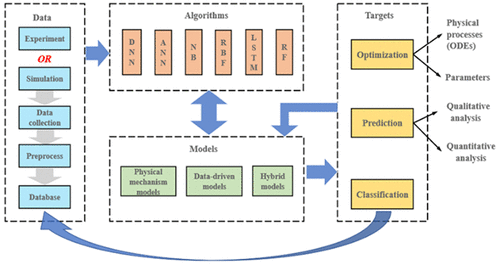当前位置:
X-MOL 学术
›
Ind. Eng. Chem. Res.
›
论文详情
Our official English website, www.x-mol.net, welcomes your feedback! (Note: you will need to create a separate account there.)
Application of Artificial Intelligence in Computational Fluid Dynamics
Industrial & Engineering Chemistry Research ( IF 4.2 ) Pub Date : 2021-02-15 , DOI: 10.1021/acs.iecr.0c05045 Bo Wang 1 , Jingtao Wang 1, 2
Industrial & Engineering Chemistry Research ( IF 4.2 ) Pub Date : 2021-02-15 , DOI: 10.1021/acs.iecr.0c05045 Bo Wang 1 , Jingtao Wang 1, 2
Affiliation

|
This review discusses the recent application of artificial intelligence (AI) algorithms in five aspects of computational fluid dynamics: aerodynamic models, turbulence models, some specific flows, and mass and heat transfer. Currently, there are three main coupling models. The first is the data-driven model to obtain the input–output relationship without involving any physical mechanisms. The second is the physical model to optimize the existing models by AI algorithms. The third is the hybrid model involving both data and physical mechanisms. Among various AI algorithms, artificial neural network is usually applied to build data-driven models and has been successfully employed in the mentioned five fields. Other AI algorithms such as recursive neural network, support vector machine, and naive Bayes are mainly used for the physical models. Finally, the development tendency of coupling models and how to choose an appropriate model are given in the conclusions and prospects.
中文翻译:

人工智能在计算流体动力学中的应用
这篇综述讨论了人工智能(AI)算法在计算流体动力学的五个方面的最新应用:空气动力学模型,湍流模型,某些特定流动以及传质和传热。当前,存在三种主要的耦合模型。第一个是数据驱动模型,该模型无需任何物理机制即可获得输入-输出关系。第二个是通过AI算法优化现有模型的物理模型。第三是涉及数据和物理机制的混合模型。在各种AI算法中,人工神经网络通常用于构建数据驱动的模型,并已成功应用于上述五个领域。其他AI算法(例如递归神经网络,支持向量机和朴素贝叶斯)主要用于物理模型。最后,
更新日期:2021-02-24
中文翻译:

人工智能在计算流体动力学中的应用
这篇综述讨论了人工智能(AI)算法在计算流体动力学的五个方面的最新应用:空气动力学模型,湍流模型,某些特定流动以及传质和传热。当前,存在三种主要的耦合模型。第一个是数据驱动模型,该模型无需任何物理机制即可获得输入-输出关系。第二个是通过AI算法优化现有模型的物理模型。第三是涉及数据和物理机制的混合模型。在各种AI算法中,人工神经网络通常用于构建数据驱动的模型,并已成功应用于上述五个领域。其他AI算法(例如递归神经网络,支持向量机和朴素贝叶斯)主要用于物理模型。最后,



























 京公网安备 11010802027423号
京公网安备 11010802027423号